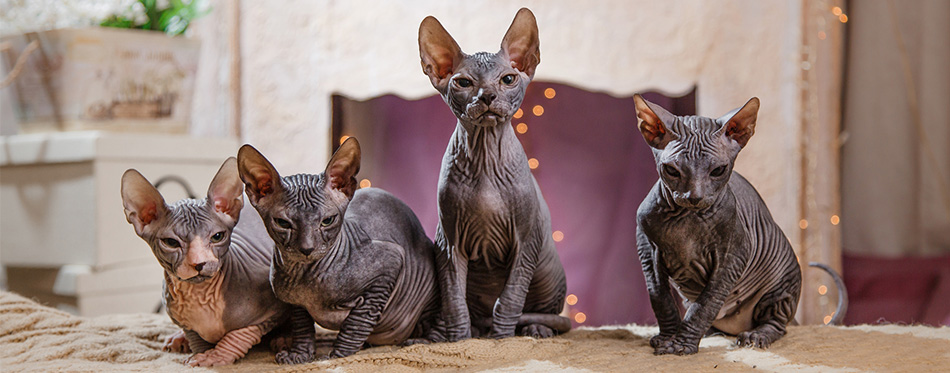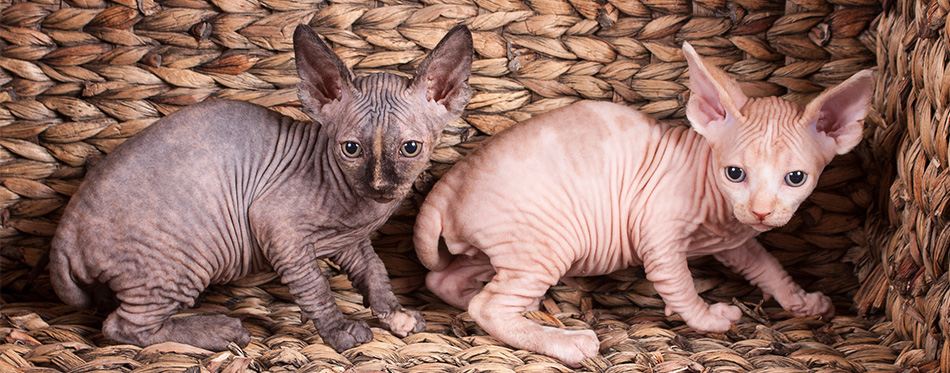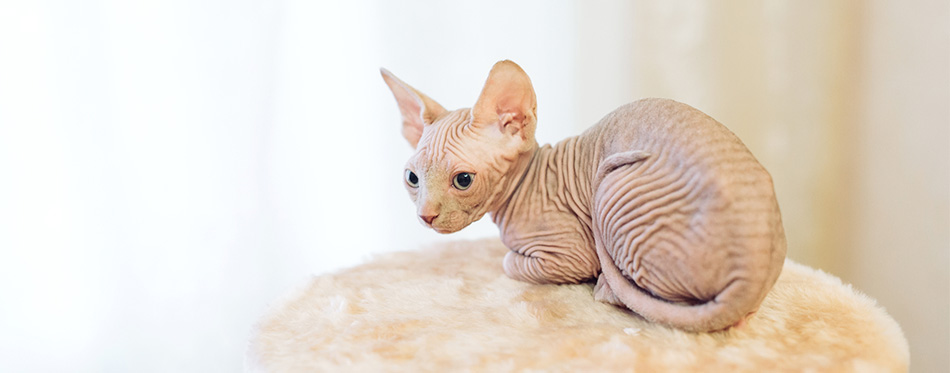Have you ever considered owning a Sphynx when deciding on adopting a domestic cat breed? The Sphynx is a great option for several reasons and will provide you with an interesting talking point with guests in your home at the very least.

History
The Sphynx cat, a breed of the hairless domestic cat, was created by two random mutations in shorthaired cats. The first mutation happened in 1975 when a cat named Jezabelle, a stray, gave birth to a hairless female kitten, followed by another the following year. The second occurred in 1978, when three hairless kittens were rescued from the streets of Toronto, Ontario, Canada.
After purchasing these hairless kittens and initially calling them the “Canadian Hairless” breed, Ridyadh Bawa, a science graduate of the University of Toronto, worked with his mother – who was a Siamese Cat breeder – to develop a breed of cats to be the official “Sphynx” breed. Bawa also received the help of Kees and Rita Tenhoves, who were the first people able to determine the recessive nature of the Sphynx gene for hairlessness, and taking this knowledge to create a successful breeding program.
After several months of trial and error, the hairless kittens were capable of reproducing more of the breed. The Tenhoves were able to get the new breed provisional showing status in the early 1970s, but had it revoked when there were concerns about the fertility of the cat breed.
The initial breeders of the Sphynx had general ideas about their genetics, so they struggled for many months trying to diagnose issues (such as a limited gene pool), and in this process, many kittens died. Another component of the health issues was the recurrent convulsions happening in several of the female cats.
The first publicly recognized naturally occurring Sphynxes were found as stray barn cats in Minnesota in 1975. These cats were taken and sold to a local cat breeder, who eventually became one of the biggest cat breeders of Sphynxes and an integral part of the breeding program.
Quick Facts
If you’re considering bringing a Sphynx into your own home as your loving family cat, there are some important facts to know so that you feel well-educated before making your decision. To help you decide whether you should have a Sphynx as part of your family, it’s best to go through basic information about the breed first.
Here are 10 facts about the Sphynx cat breed:
- Even though Sphynxes appear totally hairless, the Sphynx is actually covered with a thin layer of down-like hair, with a similarity to peach-fuzz found on ripe fruits. This makes them soft and oily to the touch, even though they look like they may feel coarse (due to their appearance, which is portrayed negatively in the media).
- Some people recommend owning a Sphynx if you’re otherwise allergic to animal fur, but this is definitely not the case! The Sphynx is not hypoallergenic cat. In fact, the saliva and skin of the Sphynx are the source of protein that causes people with allergic reactions to fur to be triggered. If you have an allergy to animals and spend time with a Sphynx, you are still likely to have an allergic reaction. If you’re allergic, but insistent on having this type of animal, you can take regular daily medications that prevent the allergic reaction from happening.
- The Sphynx is named after it’s similar look to that of the ancient Egyptian’s Sphinx. Due to this similarity, people naturally believe the breed originated in Egypt and the statues were created in it’s honor, but the truth is far from it. Ancient Egypt very likely had cats with fur, but could not convey fur with the stone they were using to capture their image. People like to believe their Sphynx cats have a more historic backstory, but were actually found on the street in Canada and in a barn in the United States. They’re still beautiful cats, regardless of their background!
- Sphynx need to be kept in the house during the hottest part of the day to prevent sunburns on their skin, as they are hairless and prone to sun damage. Sunscreen developed specifically for hairless cats can be used on your Sphynx to help protect them and their sensitive skin. Alternatively, these cats need to be protected from cold weather to stop them from freezing and getting cold burn. To prevent hurting your Sphynx, keep it inside your home at a moderate temperature and provide blankets for it to sleep on and under.
- The Sphynx is a sweet, playful, and cuddly cat that loves to spend time with people, dogs, and other cats, which is an unusual trait in many domestic cats. The friendly Sphynx is easy to handle and so is good for cat shows, being therapy cats, and an introductory pet to have in your home with children. It is happy to meet new people and will be the first to greet people at the door, similar to a friendly dog’s demeanor.
- People tend to think Sphynx cats are super clean because they don’t have fur, but this is far from the truth. While your cat’s coat may not collect dust particles, pollen, or other outdoor dirt, its skin still produces oil. For most cats, oil help keeps their fur sleek and clean. However, with Sphynx cats, it can form a greasy film over their bodies—meaning they must be given regular weekly baths. The same applies for their ears – since there aren’t any hairs to block dirt from getting inside of their ears, Sphynx owners have to regularly wipe them down to keep them clean and free of infection.
- While people absolutely love furry cats like Maine Coons and Persians, Sphynxes are currently ranked the 8th most popular feline breed in the country, according to the Cat Fanciers’ Association registration statistics from 2014. This ranking has increased exponentially since those original statistics, as the breed has skyrocketed in popularity thanks to their use in popular media. Some popular Youtube figures (such as SuperFruit) have increased their popularity by owning one and regularly featuring it on their Youtube channel. While a lot of people find the breed creepy, just as many people find them endearing.
- Though the Sphynx lacks a proper domestic cat coat, they still have a variety of colours and pattern variations that they come in. Some of the colours and patterns created and found in these cats are: white, black, red, chocolate, lavender, tabby, tortoiseshell, calico, pointed and mink. There is no one specific way for the Sphynx to look, although you may be able to find a breeder that breeds them in a specific way to match your needs. The most commonly purchased Sphynx is the calico or tortoiseshell due to their beautiful colors and markings.
- Bigglesworth (a Sphynx cat character from the Austin Powers movie series) is played by a champion purebred hairless Sphynx cat named SGC Belfry Ted Nude-Gent, bred by a woman named Michelle Berge. Filming of the three Austin Powers films was apparently delayed more than once because of Ted’s fondness for Mike Myers, whom he would be found sleeping with often.
- When adopting a sphynx cat, avoid breeders who refuse to offer a health guarantee on kittens or claim their line HCM (hypertrophic cardiomyopathy) free. Although this condition isn’t hereditary, it’s a fairly common form of heart disease in cats of all domestic breeds and no breeder can guarantee with absolute certainty that a cat won’t develop HCM. Accepting that your animal may develop a health issue and need medications is part of owning an animal and will need to be recognized at some point during ownership.
After learning those 10 facts, you are sure to be well on your way to deciding whether you want a Sphynx sweetheart in your home, or another domestic cat breed.

Things You Should Know
- Health
The Sphynx feline requires an alternate eating regimen from the remainder of feline breeds. These felines are secured by such short slim hair that it’s practically imperceptible to the eye and contact: coming up short on a thick layer of hide, their thermoregulation is increasingly perplexing, as they need to keep cleaning themselves. This distinction in digestion makes the Sphynx devour more sustenance than some other feline of a similar size. When thinking about a Sphynx feline, it is common to provide it with an uncommon eating routine. Search for explicit sustenances in your nearby pet stores: they should fit the dietary requests of the breed, which requires more protein and fat in its eating routine than breeds with hide. While the eating routine for an ordinary feline ought to incorporate 30% protein and 20% fat, the Sphynx needs at any rate 35% protein and 25% fat.
Sphynx felines sweat and amass on their skin a layer of defensive fat with a sleek surface. This makes them get dirtier than felines with hide. What’s more, they can’t clean themselves appropriately, so are reliant on their guardian for legitimate cleanliness. Whenever filthy, Sphynx felines effectively turned out to be awkward and even depressed. Although an every other week or month to month shower is for the most part suggested, not all Sphynx felines get messy as fast. Hence, you ought to know about the surface of your feline’s skin and figure out how to see the collection of soil, which can likewise result in a rosy tone in its dermis. Keep in mind that the little creases in a Sphynx feline’s skin will in general aggregate earth and smaller scale living beings, causing the presence of scabies, among different sicknesses.
To wash your Sphynx feline, utilize explicit items for this breed. Overabundance washing or utilizing unsatisfactory items may cause oily skin and even serious bothering of its sensitive dermis. In the event that you can’t find explicit items for Sphynx felines, use cleanser for felines with delicate skin and feline wipes.
Sphynx felines often don’t have eyelashes, so eye care ought to be more thorough than what is regular in different breeds. They are increasingly inclined to eye diseases, and thusly steady cleanliness is foremost. Immerse a sterile cloth with saline arrangement, which can be obtained in medication stores or a few grocery stores, and cautiously wash the feline’s eye. Utilize an alternate cloth for each eye. You should likewise keep up an extensive cleanliness routine for the Sphynx feline’s ears, which tend to aggregate bugs, oil and wax if not cleaned with suitable recurrence. Utilize a sterile bandage to clean your feline’s ears.
- Feeding
It is an incredible plan to nourish your Sphynx feline not once, yet a few times each day with littler sums on every admission. Offering a few dinners for every day is a more beneficial alternative for Sphynx felines, as this will enable their bodies to deal with their vitality levels in a superior manner. Additionally, felines that just eat a major bit of nourishment a few times per day will in general eat more and in this way, put on weight.
Note that wet cat food is 70 to 80% water, so the measures of wet food you feed your feline will be significantly greater (contrasted with dry cat food).
Furthermore, utilize good judgment to modify your Sphynx feline’s day by day admission. On the off chance that you see your Sphynx feline is putting on weight, you ought to decrease the measure of sustenance you are bolstering your feline!
In the event that you bring another sustenance into your Sphynx feline’s eating routine and you see they vomit or have looseness of the bowels, that is a reasonable sign you should quit nourishing them with that specific food.
For more guides on choosing the right cat food, you may wish to check out our reviews of the best wet cat food, cat food for sensitive stomachs, cat treats, high fiber cat food, cat food for constipation.
- Care/Grooming
As previously mentioned, Sphynx are unimaginably helpless against hot and cold temperatures. Keeping up body temperature for a bare feline can be trying for each season and family unit. One reason sphynx are so cuddly is on the grounds that they cherish heating up from your body heat. One approach to guarantee they remain warm in chilly temperatures is to give a lot of covers to them to envelop themselves by. You can likewise provide a cat bed.
A few people like to dress their felines up yet it’s essential to not compel this on your feline. A few felines love garments while others will hate them. Focus on their behavior when dressing them up. Since their skin is so sleek and sweat-soaked, you should wash their garments regularly.
Sphynx can likewise overheat effectively so make certain to give a lot of cool air on those hot and damp days. Another way that sphynx can keep warm is by their quick digestion. This implies they should be bolstered all the more regularly to suit this brisk digestion. Sphynx are additionally known to be exceptionally liberal eaters, so as long as you feed them a nutritious feast, your feline will have the essential eating routine for their fast digestion to keep them warm.
For more help on cat grooming, you may wish to read our guides on the best cat ear cleaners, cat nail clippers, brushes for cats, cat grooming gloves and cat shampoos.
- Temperament
The Sphynx has a trademark position, where it holds one of its front paws up and tucked back under its paunch. They don’t particularly like being held or petted enthusiastically, despite the fact that they do love to lay on laps, gaining them the name “the velcro lap feline”. Sphynx like to be on warm, delicate surfaces as opposed to on the ground or floor. Basic spots to discover these felines are over PC screens, in radiant windows, on a TV or tucked under a cover. They are notable for laying down with their proprietors under the spreads, as they are never-ending heat-chasing. The normal interest of the Sphynx can lead it into conceivably risky circumstances. They surely ought not be let unattended alone at entryways for any significant lot of time.
Sphynx regularly welcome their proprietors (or some other individual, so far as that is concerned) at the front entryway, with clear energy and bliss. Regardless of whether an individual is partial to this wrinkled feline, or whether an individual is not exactly eager about its appearance, everybody has a response to meeting their first Sphynx. The Sphynx has been alluded to as “the ET of the feline world.” This is a smart, curious, very cordial breed that is uncommonly favored by people.
Whether the appearance of the Sphynx frightens you or makes you coo at them with enthusiasm, they make a wonderful domestic cat breed to own and have in your home.
You will quickly realize how affectionate, intelligent and active these cats are and won’t regret bringing a hairless kitten into your family. Even if you have a dog or young children, the Sphynx is still a great option to be a lifelong companion.
To bring one of these soft, gentle felines into your home, contact a local Sphynx breeder to discuss your options or browse through some animal shelters that may have one already up for adoption! Be aware that animals found in animal shelters may not be purebred, as it is unclear who the parents are or where the cat has come from.

Sources:
- Sphynx Cat – PetMD
- About the Sphynx – CFA

